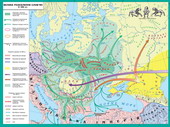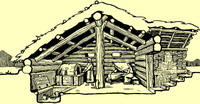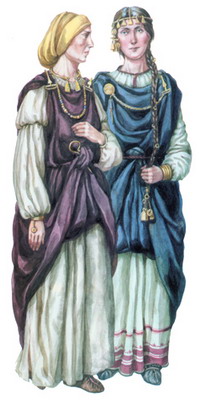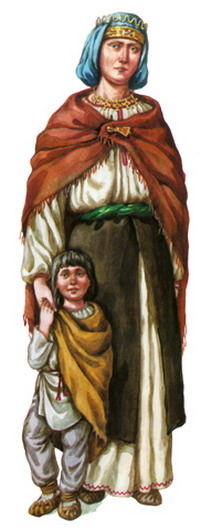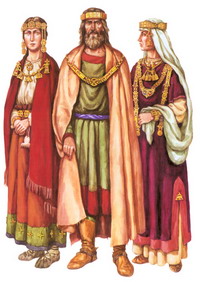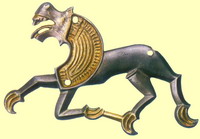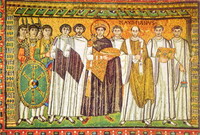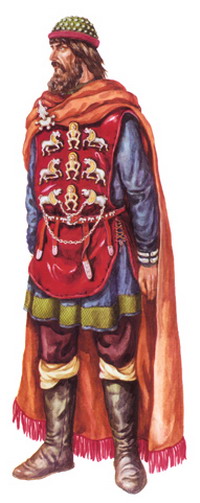Ancient Slavs
Plan presentation
- Real Slavic monuments.
- written sources about the Slavs.
- Politics.
- Facilities ancient Slavs.
- Slavs during the Great Migration. Under the rule of the Goths and Huns. Military campaigns against Byzantium, the Slavs. Resettlement of the Balkan Peninsula. The settling of the Slavic tribes along the Danube. Settling to the north. The birth of modern East nations.
- origins of the Ukrainian people.
basic concepts and terms
Ancient Slavs - a group of tribes belonging to the Indo-European community - ancestors of the Slavic peoples of Eastern, Central and Southern Europe.
Slavs - a large group of European nations, united by a common language and proximity origin. In the default language regarding division of the eastern (Ukrainian, Belarusian, Russian), western (Poles, Czechs, Slovaks and Sorbs) and southern (Bulgarians, Macedonians, Croats, Slovenes, Bosnians, Montenegrins, Serbs). Slavic languages belong to the Indo-European language family.
Migration - grand ethnic migration, which took place in Europe at 4.6 cent . Caused by the invasion hunskoyu Migration caused the formation of a number of barbarian kingdoms - Goths, Vandals, burhundiv, Franks, Lombards and others. Large resettlement nations and led to the so-called Great settlement of the Slavs .
large settlement of the Slavs was in Europe at 7.6 cent. when the Slavic tribes appeared in the Danube, in deep areas of the Balkan Peninsula - in the south, west reaching the Elbe and the Baltic coast in the north east inhabit the Upper Don and Volga. As settlement of the Slavs of Great was started by the division of the Slavs on ethnic groups that initiated the formation of modern Slavic peoples.
Byzantium, the Byzantine Empire - the state that existed in the eastern part of the Roman Empire from late April to mid 15 century. Got its name from the ancient colony on the shores of the Bosphorus - Byzantium, to which place the emperor Constantine in 330 established the state capital - Constantinople. Byzantium was regarded as the successor to the Roman Empire, as the Byzantines called themselves Romans - "Romeo" and their country "romeyskoyu. The official language in the 4-6 cent. was Latin, and Greek.
Gauthier - the general name of ethno-political union of Germanic tribes first half pre BC Natives of Scandinavia, which at the beginning of our era, migrated to the Baltic, and later moved to the southeast up to the Black and Azov Seas. It created a tribal alliance, the so-called Gothic State defeated Huns in the 5 century.
Huns - Turkic-speaking people who prykochuvav in the steppes of Ukraine from the territory of Mongolia and China, replacing the Iranian nomads, and opened the era of the Great Migration, during which greatly formed modern ethnic map of Europe.
Avars - a great alliance of nomadic Turkic tribes. In 6 centuries. came from Asia through Ukrainian territory on the Danube and established their own state there Avar khanate.
 Venedi - ancient Slavic name under which they are mentioned in ancient sources and art. and therefore the oldest Slavic etnopleminne association. At that time the Veneti occupied land between the north of the Pripyat, the Vistula in the west and the south of Middle TN, no clear definition of the eastern borders.
Venedi - ancient Slavic name under which they are mentioned in ancient sources and art. and therefore the oldest Slavic etnopleminne association. At that time the Veneti occupied land between the north of the Pripyat, the Vistula in the west and the south of Middle TN, no clear definition of the eastern borders.
 Anti - etnopleminne old Slavic union, which occupied the territory between the Dniester and Dnieper. Archaeological corresponded Ants are penkivska culture. In 6 centuries. anti with other Slavic tribes were actively involved in the colonization of the Balkans, the Slavs in wars against Byzantium. Last record of 602 dates from Ants in connection with the hike Avar punitive squad for their extermination. However, archaeological materials show that the settlement Ants and their descendants there and after that - for all 7 of art. Together with other groups of early anti involved in the ethnogenesis of eastern, western and southern Slavs.
Anti - etnopleminne old Slavic union, which occupied the territory between the Dniester and Dnieper. Archaeological corresponded Ants are penkivska culture. In 6 centuries. anti with other Slavic tribes were actively involved in the colonization of the Balkans, the Slavs in wars against Byzantium. Last record of 602 dates from Ants in connection with the hike Avar punitive squad for their extermination. However, archaeological materials show that the settlement Ants and their descendants there and after that - for all 7 of art. Together with other groups of early anti involved in the ethnogenesis of eastern, western and southern Slavs.
Sklavyny - etnopleminne combining ancient Slavs, which occupied the territory between the Dniester and the Danube. Archaeological sklavyniv is equivalent to Prague-korchatska culture.
Timeline
|
4-6 centuries. |
Migration |
|
6-7 centuries. |
large settlement of the Slavs |
main presentation
1. Real Slavic Attractions
-

 Slavic origins archaeologists have yet to see the farming tribes of steppe that they had to guard against militant Cimmerians.
Slavic origins archaeologists have yet to see the farming tribes of steppe that they had to guard against militant Cimmerians.
- But it would wrong to say allegedly chornoliska population - slaves. This is only the origin of some signs of spiritual life, welfare and economy inherent in later times Slavs.
- Century by century - and in the archaeological cultures of the steppe Ukraine becomes more such features, allowing researchers to call our land Slavs originated .
- Undoubtedly, however, that under conditions of constant change habitats for different peoples, as so often in ancient times, the ancestors of the Slavs and a diver, Mastering significant territory and living there together with other people.
- Not surprisingly, many scientists associated with the origin of the Slavs wider territory - from the Oder to the Dnieper River .
Features real monuments of ancient Slavs
- old Slavic settlement located teams at a short distance from each other on the banks of rivers.
- for housing in their regulations napivzemlyanky or dugout or a braided composite with felled trunks and walls of fire, and from 5 cent. district. BC - with a stone oven on the floor.
The dead - odnoplementsiv Slav Slavs and mostly burned.
- stoneware sculpted hands, without pottery wheel, occasionally ozdoblyuyuchy different patterns.
 Since the beginning 1 thousand district. e. number of Slavic sites steadily increased, but archaeologists still are not lucky enough to open the archaeological culture to 5 centuries. that he would completely pre-Slavic or Slavic tribes.
Since the beginning 1 thousand district. e. number of Slavic sites steadily increased, but archaeologists still are not lucky enough to open the archaeological culture to 5 centuries. that he would completely pre-Slavic or Slavic tribes.
-
 Up to 5 centuries. Slavic monuments were part of the archaeological monuments of culture along with other nations. Thus, on the verge er distinguish them in two cultures: Zarubynec'k , which included the territories of Ukraine and Belarus, and Przewor , widespread in Poland.
Up to 5 centuries. Slavic monuments were part of the archaeological monuments of culture along with other nations. Thus, on the verge er distinguish them in two cultures: Zarubynec'k , which included the territories of Ukraine and Belarus, and Przewor , widespread in Poland.
In - Zarubynec'k Slavic culture are major attractions in the presence of the Baltic and Germanic. In Przewor are insignificant next to the main Germanic-Celtic.
In - 3 tablespoons. district. BC on the territory of Ukraine with Slavic tribes originated Slavic culture , which covered the ground between the Pripyat and Desna the north and the Black Sea and Danube in the south. Along with its Slavic tribes created the Goths, Scythians, Sarmatians, Thracians and others.
Actually - Slavic archaeological culture in the forest-steppe of South-Eastern Europe faced 5-6 cent. district. e .
2. Written sources about the Slavs
-
 Inhabiting remote from the turbulence of contemporary European history and territories without their own written language, the Slavs came relatively late to the pages of books.
Inhabiting remote from the turbulence of contemporary European history and territories without their own written language, the Slavs came relatively late to the pages of books.
- earliest evidence of them belong to the new era. They belong to the Roman historian 1-2 Art. Pliny the Elder, Tacitus and geographers Ptolemy (2 c.)..
- All three were called Veneti Slavs and spoke of them as separate people who lived east of the Vistula river, surrounded by Germans, Thracians, Sarmatians, Balts.
-
 According to archeologists, it wends meet Zarubynets'ka and Slavic archaeological culture in Slavonic their part.
According to archeologists, it wends meet Zarubynets'ka and Slavic archaeological culture in Slavonic their part.
- Ptolemy, among others, from among tribes also called wends stavaniv. This title sees some linguists distorted synonymous "Slavs".
- general evidence of Roman historians - stingy on facts and very controversial.
- more telling about 6 tablespoons of Slavs sources. and later centuries. Great attention to them, in particular, paid by the history of the Goths Jordan in his book On the Origin and act hetiv "(another name of the book -" deve lopment ") 551 was « These Veneti derived from the same root and are known today under three names: wends, Ants sklavyniv ... »- said Jordan about the Slavs.

 names «sklavyny» and «anti» on next to the Slavs " ; Veneti "there and elsewhere. They confirm the division of the ancient Slavs in various tribal associations. Yes, Jordan, Veneti lived in the Vistula, anti - in the Dnieper Basin, sklavyny between the Dniester and the Danube.
names «sklavyny» and «anti» on next to the Slavs " ; Veneti "there and elsewhere. They confirm the division of the ancient Slavs in various tribal associations. Yes, Jordan, Veneti lived in the Vistula, anti - in the Dnieper Basin, sklavyny between the Dniester and the Danube.
According to archeologists, was another tribal union of the Slavs, who lived in the upper reaches of the Dnieper. But due to the remoteness of the tribes of the Roman-Byzantine world, their name, albeit conditional, not preserved.
On the Origin of the names on their uzhyvaly Slavs ancient historians strangers, Ukrainian scientists adhere to this opinion: two of them - Veneti and anti - is a foreign-language (first - Germanic, the second - of Iranian origin); a third, sklavyny, - modified synonymous "Slavs". So ethnonym "Slavs" is used in the sources of 6 centuries.
3. Public life
-

 Archaeological finds no objection to this evidence, and vice versa - insist that the Slavs from the very beginning of its history, acted as separate, though related, larger or smaller groups - union families - tribes, tribal unions.
Archaeological finds no objection to this evidence, and vice versa - insist that the Slavs from the very beginning of its history, acted as separate, though related, larger or smaller groups - union families - tribes, tribal unions.
- Tribes led by elected community leaders . leaders elected from among the natives of the richest families.
It - fact the leaders at Caesar , the powers which belonged to more redistribution of products produced, the organization of defense during military events, military equipment etc. wives. Government leaders later became hereditary.
- When demand appeared strong guard against the enemy, Slavic tribes united in major military alliances . An example of such a union can be antske association.
formation of large alliances of tribes scientists believe such a level of social relations that preceded the state. Thus, the ancient Slavs in 5-7 centuries. uprytul approached the creation of the state.
-
 on peredderzhavnyy level of public relations in the ancient Slavs shows the arrangement of their settlements. Smaller settlements with larger skupchuvalysya around - a sort of breeding centers.
on peredderzhavnyy level of public relations in the ancient Slavs shows the arrangement of their settlements. Smaller settlements with larger skupchuvalysya around - a sort of breeding centers.
Last - were manufacturing center. Subsequently, such large settlements turned into fortified settlement.
- Remains great Slavic tribal center archaeologists have found, for example, in Volyn - it Zimne Settlement .
- relatively complex social relations in the Slavs, the forming of their tribal leadership - Elite - 6 tablespoons sources indicate.
- example, one of them warns that in many Slavic leaders. Another author, already mentioned Gothic historian Jordan spoke about the massacre of the Gothic King Bozhem Slavic leader, his supporters and 70 children-elders.
- not contradict the stories of ancient historians and archaeological treasures of the Slavic territories, which ruled for life, certainly the richest and empowered representatives of the Slavic tribes.
- Among these attractions and Martynivskyy treasure , which, scientists assumed, belonged to someone with antskyh leaders.
- much evidence indicates a special role in the life of the Slavs of joint councils, which uhvalyuvalysya important decision. « These tribes, and anti sklavyny not be one person, - wrote in a 6 cent. Procopius of Caesarea, - and from ancient times living in a democracy, so all that useful for them or bad, they heed together ».


4. Facilities ancient Slavs
- ancient Slavs lived with Agriculture and cattle settled .
- They grew millet, barley, wheat, rye, oats, flax and hemp, preferring under spring varieties.
- sow winter crops have been taught in the second half of 1 thousand
- The animals bred great and small cattle, sheep, pigs and horses.
- Living among forests in the land of rivers and lakes, the Slavs not neglected millennial hunting and fishing experiences.
- Among the handicrafts made of special CASTING and forging .
- Among the blacksmiths ancient Slavs especially revered master jewelers.
- peculiar were Slavs in production pottery .
- long time, even after other nations had borrowed wheel, pottery, especially one that was used for cooking, remained stucco .
- flourishing pottery production took place in our lands for 3-4 centuries. - At times Cherniahivs'ka culture.
- During the Great Migration pottery declined, so the pottery vessels lost to the Slavs before the stucco up to 11.10 cent.
- Development Trade certify many finds of coins of various nations. Slavs gladly traded with a population of Danube, Central Europe and Baltic countries, and later - with the inhabitants of the Roman and Byzantine ancient cities and provinces of Northern Black Sea Coast.
- In Slavic lands at that time fell tableware, glassware, bronze, silver and gold, wine, oil.
Instead - were removed furs, honey, wax, hides, grain.
In - 6.7 cent. Slavic tribes controlled the Dnieper Dnieper trade routes that connected the Baltic and Black Sea.
5. Slavs during the Great Migrations
Ants and Resettlement
sklavyniv occurred at a time known in history as Migration . Over by him, the Slavs took active part in military events, gaining experience in public life, which subsequently implemented in their own countries.
Under the rule of the Goths and Huns
-
 in 3 tablespoons. goths finally established in the Black Sea steppes. Their state united many people of those lands, including Slavs, Antes.
in 3 tablespoons. goths finally established in the Black Sea steppes. Their state united many people of those lands, including Slavs, Antes.
- Gothic domination fell during the invasion of the Huns . With the support of anti overcame the Goths.
- In stock hunskoho association Slavs making its way to the Danube and the Balkans, acting then as allies nomads, how their subordinates.
- The greatest power of the Huns reached during Attila , and after his death in 453, the fast weak.
- got rid of their dependence on the Huns, Slavs powerful stream of earth moved to Byzantium. Thus began great settlement of the Slavs .
military campaigns against Byzantium, the Slavs. Resettlement of the Balkan Peninsula
- first independent trips to the Slavs Byzantium held in late May - early June centuries.
-
 Almost every year there have Slavic military expedition to the Balkans by the Emperor Justinian (527-565 years).
Almost every year there have Slavic military expedition to the Balkans by the Emperor Justinian (527-565 years).
- And after he began a campaign 550-551 mass migration of Slavs, Antes, and the Balkans. Contemporary sources say that before you lay the village, slaves carried out military operations, during which ruined fortress.
- end of 6 centuries. permanent Slavic settlements occur everywhere in the Balkans.
 therefore the result of military campaigns against Byzantium was the resettlement of Slavonic tribes on earth Balkans.
therefore the result of military campaigns against Byzantium was the resettlement of Slavonic tribes on earth Balkans.
- end of 6 cent. Ants in relations with Byzantium intervened Avars - nomadic people of Turkic origin who have made their country - kaganat - in the Middle Danube.
- accidents prompted the need to counter the former rivals to unite.
- Year with 601 anti Byzantium opposed Avars, on the side of which, however, fought sklavyny.
Next year - Avars made another expedition against the Ants.
- Contemporary sources are silent about who won. However, the name of Ants 602 p . no longer mentioned.
- is believed that the powerful military alliance antskyy collapsed, and to Slavic tribes that were part of his composition, a new phase in their history - the life of the Balkan lands, surrounded by other people, which gave rise to modern South nations.
Slavic tribes settling on the Danube
- Archaeological sites indicate that the migration flow of the Danube and the Balkans were not only anti and some will sklavynskyh tribes.
And when anti - seized lands Balkans oselyayuchys there often with accidents and Bulgarians, sklavyny moved to the banks of the Danube, paving his way up the Danube to the west.
- Eventually they moved up to the top of the Elbe, mixed with Slavic tribes that moved up there from Poland, and surrounded by Germanic tribes gave rise to the modern West Slavic peoples.
Note!
Division Slavs in western, eastern and southern Slavs corresponds to-date. As pointed researchers in 8-9 centuries. there was neither east nor west, nor south Slavic community, but were eastern, western and southern Slavic tribes or their unions, on which stood many Slavic peoples .
settling to the north. The birth of modern nations of East
- already mentioned that in the upper reaches of the Dnieper, the Left, 5-7 cent. also inhabited by Slavic tribes. Their lives verified by archaeological finds, but the name of those tribes has not survived.
- Ancient Slavs - the inhabitants of the Upper Dnieper - emphasis omitted Byzantine authors, because their families did not participate in expeditions to the south.
- Living next to the Baltic population, they were involved in the events center of which stood the Baltic.
- gradually these tribes were settled far north.
- Those who advanced in a north-westerly direction, then gave life to the people of Belarus. Those who went to the northeast, became the ancestors of the Russians.
6. The origins of the Ukrainian people
-
 for a long time in science was suggested that the Ukrainian ancestors were anti.
for a long time in science was suggested that the Ukrainian ancestors were anti.
However - latest archeological findings prove that the monuments of later time, which is the proper Ukrainian, appeared not only on the basis antskyh sites , and mostly based on monuments that were left by sklavyny .
For it - sklavyny were the population, which lived 5-7 centuries. in most Ukrainian Right Bank.
Anti - , whom sources say that time that they lived in the Dnieper, from 6 centuries. began to move south, the Balkan Peninsula.
Part - antskoyi population that did not participate in resettlement sklavynamy was absorbed, and in memory of Ants on the territory remained Podniprov'ya name, which, according to many researchers owe their ethnonym modern Ukrainian.
- Iranian word «anti» means "extreme", "okrayinni. Him steppe Scythian and Sarmatian tribes have always called borderlands of the steppes local farming population. Millennial neighborhood with the Iranian people entrenching the title, which, however, local residents articulates on its own. It appeared, according to some historians and linguists, the name Ukraine.
So great migration of peoples was of great importance for the further fate of the Slavs. Picked up by him, Slavic tribes intermingled and new territories gave the beginnings of modern Slavic peoples.
 English
English
 Venedi - ancient Slavic name under which they are mentioned in ancient sources and art. and therefore the oldest Slavic etnopleminne association. At that time the Veneti occupied land between the north of the Pripyat, the Vistula in the west and the south of Middle TN, no clear definition of the eastern borders.
Venedi - ancient Slavic name under which they are mentioned in ancient sources and art. and therefore the oldest Slavic etnopleminne association. At that time the Veneti occupied land between the north of the Pripyat, the Vistula in the west and the south of Middle TN, no clear definition of the eastern borders. Anti - etnopleminne old Slavic union, which occupied the territory between the Dniester and Dnieper. Archaeological corresponded Ants are penkivska culture. In 6 centuries. anti with other Slavic tribes were actively involved in the colonization of the Balkans, the Slavs in wars against Byzantium. Last record of 602 dates from Ants in connection with the hike Avar punitive squad for their extermination. However, archaeological materials show that the settlement Ants and their descendants there and after that - for all 7 of art. Together with other groups of early anti involved in the ethnogenesis of eastern, western and southern Slavs.
Anti - etnopleminne old Slavic union, which occupied the territory between the Dniester and Dnieper. Archaeological corresponded Ants are penkivska culture. In 6 centuries. anti with other Slavic tribes were actively involved in the colonization of the Balkans, the Slavs in wars against Byzantium. Last record of 602 dates from Ants in connection with the hike Avar punitive squad for their extermination. However, archaeological materials show that the settlement Ants and their descendants there and after that - for all 7 of art. Together with other groups of early anti involved in the ethnogenesis of eastern, western and southern Slavs.
 Slavic origins archaeologists have yet to see the farming tribes of steppe that they had to guard against militant Cimmerians.
Slavic origins archaeologists have yet to see the farming tribes of steppe that they had to guard against militant Cimmerians.  Inhabiting remote from the turbulence of contemporary European history and territories without their own written language, the Slavs came relatively late to the pages of books.
Inhabiting remote from the turbulence of contemporary European history and territories without their own written language, the Slavs came relatively late to the pages of books.  According to archeologists, it wends meet Zarubynets'ka and Slavic archaeological culture in Slavonic their part.
According to archeologists, it wends meet Zarubynets'ka and Slavic archaeological culture in Slavonic their part. 
 names «sklavyny» and «anti» on next to the Slavs " ; Veneti "there and elsewhere. They confirm the division of the ancient Slavs in various tribal associations. Yes, Jordan, Veneti lived in the Vistula, anti - in the Dnieper Basin, sklavyny between the Dniester and the Danube.
names «sklavyny» and «anti» on next to the Slavs " ; Veneti "there and elsewhere. They confirm the division of the ancient Slavs in various tribal associations. Yes, Jordan, Veneti lived in the Vistula, anti - in the Dnieper Basin, sklavyny between the Dniester and the Danube. 
 Archaeological finds no objection to this evidence, and vice versa - insist that the Slavs from the very beginning of its history, acted as separate, though related, larger or smaller groups - union families - tribes, tribal unions.
Archaeological finds no objection to this evidence, and vice versa - insist that the Slavs from the very beginning of its history, acted as separate, though related, larger or smaller groups - union families - tribes, tribal unions. 
 on peredderzhavnyy level of public relations in the ancient Slavs shows the arrangement of their settlements. Smaller settlements with larger skupchuvalysya around - a sort of breeding centers.
on peredderzhavnyy level of public relations in the ancient Slavs shows the arrangement of their settlements. Smaller settlements with larger skupchuvalysya around - a sort of breeding centers. 

 in 3 tablespoons. goths finally established in the Black Sea steppes. Their state united many people of those lands, including Slavs, Antes.
in 3 tablespoons. goths finally established in the Black Sea steppes. Their state united many people of those lands, including Slavs, Antes.  Almost every year there have Slavic military expedition to the Balkans by the Emperor Justinian (527-565 years).
Almost every year there have Slavic military expedition to the Balkans by the Emperor Justinian (527-565 years).  for a long time in science was suggested that the Ukrainian ancestors were anti.
for a long time in science was suggested that the Ukrainian ancestors were anti. 